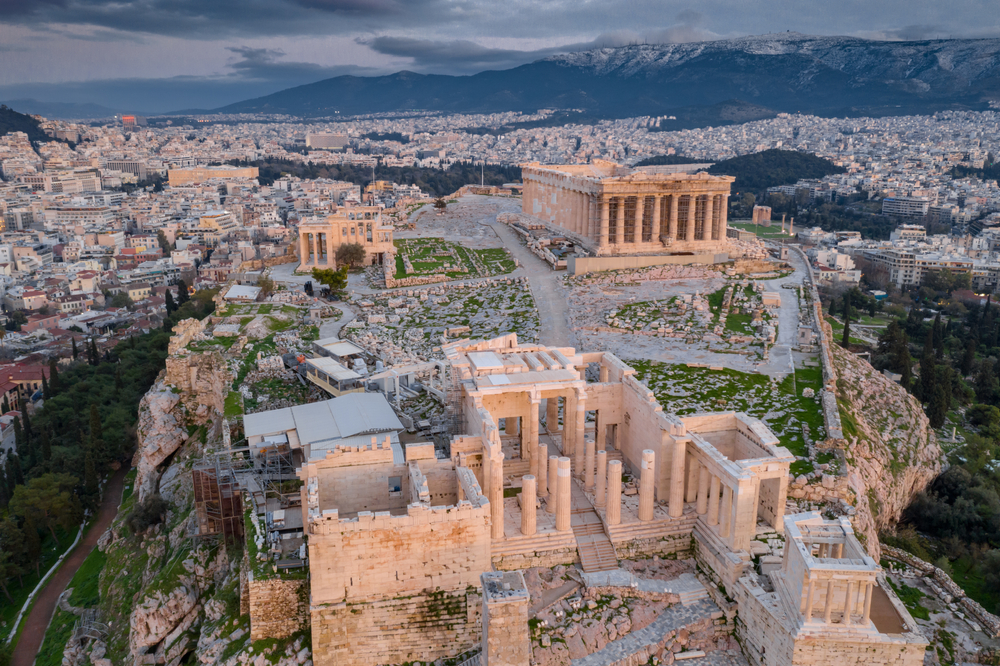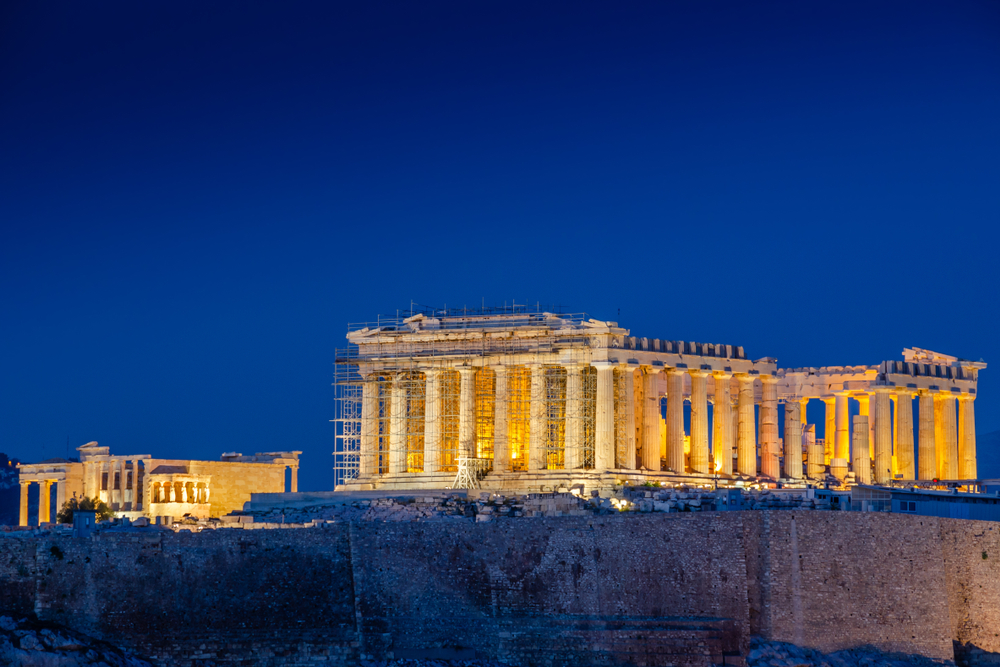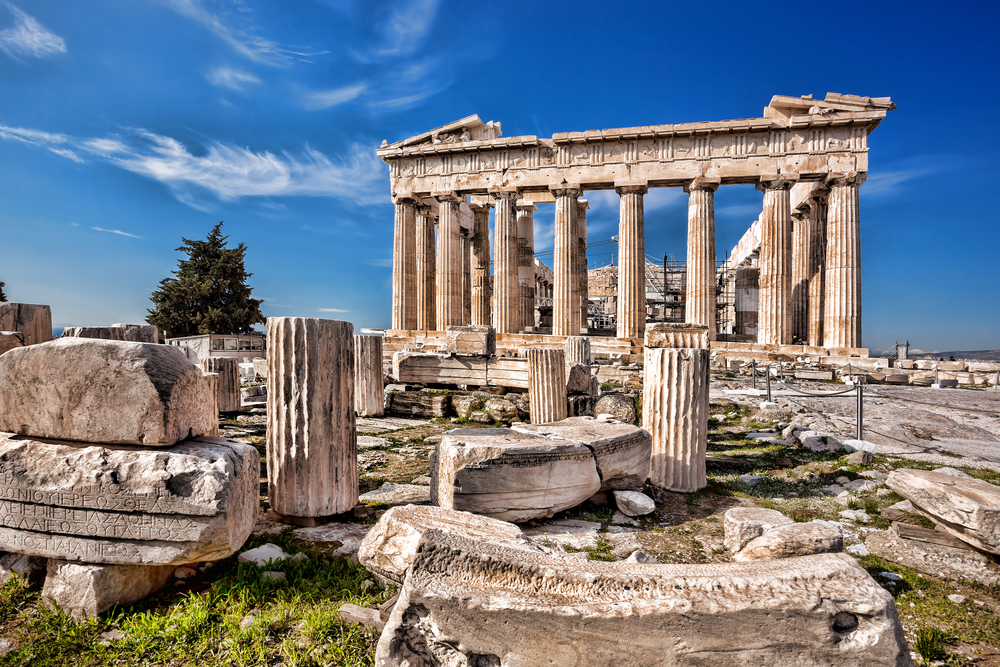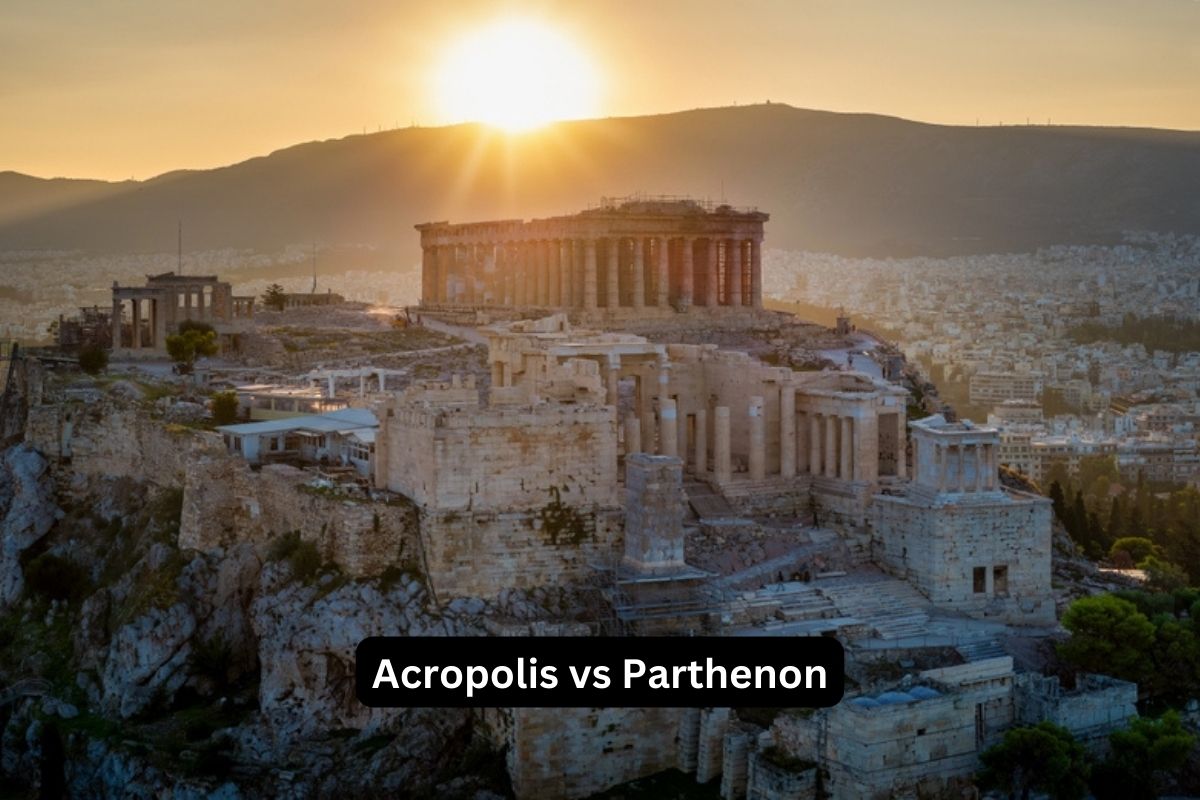The Acropolis of Athens is an ancient citadel perched above the Greek city, renowned for its historic significance and architectural brilliance. It stands as a testament to the city’s power and cultural achievements during its Golden Age.
The term Acropolis, though specific to Athens, can refer to any similarly situated historical structure, but due to the prominence of Athens in history, it is often implicitly understood to mean its Acropolis.
Within the confines of the Acropolis lies the Parthenon, a resplendent temple dedicated to the goddess Athena, who was seen as the patroness of the city. Built in the 5th century BC, the Parthenon is distinguished by its Doric architecture and the artistry of its construction, employing a refined understanding of proportion and optical illusions to achieve its imposing grandeur.
While the Acropolis serves as the fortified complex, the Parthenon stands as the jewel in the crown, encapsulating the height of ancient Greek art and architecture.
| Feature | Acropolis | Parthenon |
|---|---|---|
| Definition | A complex of structures on a rocky hill in Athens, Greece; often referred to as the high city. | A specific temple located on the Athenian Acropolis, dedicated to the goddess Athena. |
| Significance | Symbol of the classical spirit and civilization of ancient Greece; includes several ancient buildings of great architectural and historic importance. | Considered a masterpiece of ancient Greek architecture; the most important surviving building of Classical Greece and a symbol of Western civilization. |
| Construction Era | Various structures built over different periods, primarily in the 5th century BCE. | Constructed in the mid-5th century BCE. |
| Architectural Style | Includes a variety of structures with different architectural styles, predominantly Doric and Ionic. | Known for its Doric columns and exquisite sculptural details. |
| UNESCO Status | A UNESCO World Heritage Site. | Part of the Acropolis UNESCO World Heritage Site. |

Understanding the distinction between the Acropolis and the Parthenon is key to appreciating their individual contributions to historical and cultural narrative. The Acropolis, as a whole, is a symbol of the collective identity of Athens, encompassing various structures including temples, sanctuaries, and public spaces.
In contrast, the Parthenon specifically symbolizes the aesthetic and religious aspirations of the ancient Athenians, representing a focal point of reverence and artistic endeavor in the Acropolis complex.
Historical Context and Significance
The Acropolis and the Parthenon embody the pinnacle of Ancient Greek culture and its architectural achievements during the Golden Age. These landmarks serve as cultural symbols of Ancient Greece’s history and its contributions to Western civilization.
Ancient Greek Roots and the Golden Age
The Golden Age of Athens occurred in the 5th century BCE, a period of remarkable political and cultural advancements in Ancient Greece. It was during this era that the city of Athens transformed under the leadership of Pericles, becoming the political and cultural center of the Greek world. The Golden Age was defined by democratic principles, flourishing arts, and the birth of Western philosophy.
Also Read: Pantheon vs Parthenon
The Athenian Acropolis, a fortified natural stronghold, stood at the heart of Athens as the nexus of spiritual and communal life. Funded by the wealth of the Delian League, a coalition of city-states led by Athens, the Acropolis was adorned with architectural masterpieces, like the Parthenon, which doubled as a temple and a treasury.

The Acropolis: More Than Just the Parthenon
The Athenian Acropolis is an ancient citadel located on a rocky outcrop above the city of Athens and includes several ancient structures of great architectural and historic significance.
Although the Parthenon is the most iconic, with its Doric columns and stunning sculptures personifying the height of the Ancient Greek architectural marvels, the Acropolis itself is a complex of various structures. It includes the Erechtheion, the Propylaia, and the Temple of Athena Nike, each with unique historical importance, collectively serving religious, political, and commemorative purposes.
These temples and structures were dedicated to various deities and played a significant role in the religious and social life of Ancient Greeks. The Acropolis, therefore, represents a microcosm of Ancient Greek history, showcasing an ensemble of classic Hellenic art and the socio-political matrix of the time.
Exploring the Architectural Marvels
The Parthenon and the Acropolis stand as testaments to ancient Greek architecture, each with its unique features and significance. They showcase the Greeks’ command over marble, the precise use of the Doric order, and the integration of stunning sculptures and friezes.
Distinguishing Features of the Parthenon
The Parthenon is a Doric temple that dominates the Athenian skyline. Constructed from Pentelic marble, it once gleamed in the sun, visible from afar. The temple features 8 x 17 columns, with each standing at over 10 meters tall, embodying the Doric architectural style.
Notably, the Parthenon is renowned for its architectural refinements, including a slight curvature in the columns and steps to correct optical illusions.
Inside the Parthenon, the frieze and pediment sculptures tell mythological tales and celebrate Athena’s might. These intricately designed elements embody a sophistication in sculpture that is considered a pinnacle of Greek artistry.
The Acropolis and Its Structures
The Acropolis, a fortified limestone plateau, serves as the pedestal for several significant structures beyond the Parthenon. The Propylaea serves as the grand entranceway to this complex, showcasing Ionic and Doric features.
Another notable structure is the Erechtheion, a temple dedicated to both Athena and Poseidon. It is famous for its Porch of the Caryatids where six draped female figures serve as supporting columns. Unlike the Parthenon’s strictly Doric design, the Erechtheion includes ionic elements.
The Temple of Athena Nike is a small, elegant amphiprostyle temple at the Acropolis’s southwest corner. This temple also features Ionic columns and is adorned with friezes depicting historical and mythological battles, showcasing the Athenians’ reverence for Athena as their divine protector in warfare.

Cultural and Artistic Treasures
The Acropolis and Parthenon stand as monumental landmarks of ancient Greek heritage, boasting a rich array of sculptures and art, intertwined with religious and mythological themes that reflect the civilization’s beliefs and values.
Sculpture and Art of the Parthenon
The Parthenon is renowned for its decorative sculptures which exemplify the zenith of classical Greek artistry. Phidias, a prominent sculptor of the time, oversaw the artistic direction of these works.
The temple once housed a massive statue of the Greek goddess Athena, crafted from gold and ivory, a testament to the wealth and artistic prowess of ancient Athens. Much of the Parthenon’s splendor owes to its intricate architectural sculptures, comprising the frieze, metopes, and pediments. Key elements include:
- Frieze: A continuous narrative band adorning the upper part of the Parthenon’s interior, depicting the Panathenaic procession.
- Metopes: Square panels between the triglyphs, showcasing battle scenes and exploits of mythic figures.
- Pediments: Triangular sections at the end of the roof, filled with large-scale sculptures portraying famous mythical scenes, such as the birth of Athena.
The use of marble in these structures not only added to the grandeur and permanence but also allowed intricate detail and polish rarely matched in other temples of the time.
Religious and Mythological Significance
Religion closely tied with art, the Parthenon served as both a sanctuary to goddess Athena and a display of sculptural narratives portraying deities and mythological events. The eastern pediment celebrated Athena’s birth from the head of Zeus, a central religious myth.
Meanwhile, the Erechtheion, another temple on the Acropolis, provided space for more sacred rituals associated with ancient beliefs.
The Acropolis complex, including the Parthenon, functioned as a visual encyclopedia of religious tales and ideals. Art and architecture coalesced to immortalize the divine Patrons of the city, ensuring their stories remained a central part of the cultural consciousness.
The Ongoing Legacy and Conservation Efforts
The Acropolis and Parthenon continue to symbolize the historical and cultural heritage of ancient Greece. Efforts to conserve these structures are vital to preserving their legacy and ensuring they remain integral to global heritage and tourism.
Impact on World Heritage and Tourism
The Acropolis, designated as a UNESCO World Heritage site, attracts millions of tourists annually, emphasizing its significant role in the travel industry. The site’s historical importance and the beauty of the Parthenon inspire awe and appreciation, fostering a connection to the birthplace of Western civilization. The infusion of tourism revenue aids in the site’s upkeep and contributes to Greece’s economy.
Visitors often express a deep interest in the famed Parthenon marbles. Partly housed in the British Museum, these marbles spark debates regarding the preservation of cultural heritage and the repatriation of artifacts. The Acropolis Museum, near the base of the hill, was created to exhibit the Parthenon marbles and allows visitors to explore the history and challenges of conservation.
Preservation: Battles and Restoration
The Acropolis and Parthenon have withstood numerous battles throughout history. From damage inflicted during conflicts with the Ottoman Turks to the Venetian bombardment in 1687 when gunpowder stored by the Ottomans exploded, the structures faced significant threats. These events accelerated the need for restoration and conservation efforts.
Conservation battles have also taken a diplomatic form, most notably regarding the Elgin Marbles. Lord Elgin removed these marbles from the Parthenon in the early 19th century, and today they are a contentious subject between the Greek government and the British Museum. The ongoing debate emphasizes the complexity of cultural heritage preservation in an international context.
In more recent years, the Parthenon has been undergoing extensive restoration works, carefully balancing the need to preserve its ancient aspects with the structural reinforcements necessary to withstand present-day environmental pressures. These efforts aim to ensure the Parthenon’s legacy endures, respectful of both its historical significance and the role it plays in modern cultural identity.
Visiting the Acropolis: Tips and Insights
The Acropolis stands as a testament to ancient history and architecture, drawing visitors from around the world. To make the most of your visit, attention to detail and preparation are key.
Planning Your Visit
When planning to visit the Acropolis, researching in advance is vital. It is recommended to purchase tickets online to avoid long queues, especially during peak tourist seasons. Visitors should check the weather and wear comfortable shoes, as the pathways can be slippery and the terrain rocky. Early morning or late afternoon visits can help avoid the largest crowds. For an in-depth experience, consider hiring a licensed guide to enhance your knowledge of the historical site.
- Hours of Operation: Verify the opening hours before your visit.
- Ticket Costs: Costs may vary; check for updated pricing or possible discounts.
- Attire: Wear stable footwear for hiking the uneven paths.
Tourist Experience and Etiquette
During your visit, respecting the sanctity of the site is paramount. The Acropolis is not only a tourist attraction but also an important cultural and historical monument. Photography is allowed, but the use of flash is prohibited inside the temples. Eating and drinking are restricted to designated areas. Visitors should be mindful not to touch or lean on the ancient structures to prevent damage. Additionally, the Acropolis is home to the remnants of a historic mosque and an early Christian church, which require the same respect as any place of worship.
- Photography: Use natural light; tripods may require a commission.
- Preservation: Do not remove any stones or artifacts from the site.
- Respect: Keep noise to a minimum and follow the instructions of site personnel.
